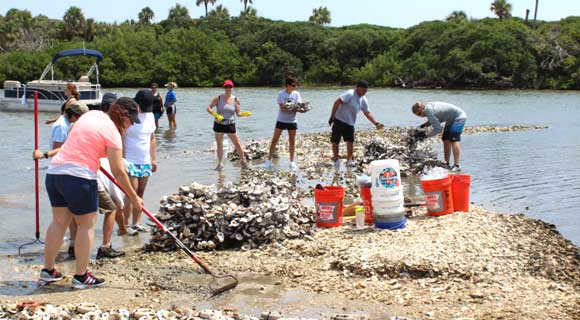Brevard Zoo, UCF Successfully Conclude Decade-Long Indian River Lagoon Oyster Mat Project
By Space Coast Daily // September 21, 2016
help from more than 48,000 volunteers

BREVARD COUNTY • MELBOURNE, FLORIDA – After 10 years, 77 reefs, 45,000 oyster mats and help from more than 48,000 volunteers, the University of Central Florida and Brevard Zoo have realized their goal of restoring oyster reefs in Canaveral National Seashore, located in the Mosquito Lagoon, the northernmost region of the Indian River Lagoon.
This is potentially enough to “recruit” 10.6 million adult oysters, each of which can filter up to 50 gallons of water per day.
Brevard Zoo is home to more than 800 animals representing 180 species from all over the world. As a not-for-profit organization, it is a leader in the fields of animal wellness, education and conservation.
Ten years ago, UCF partnered with the Nature Conservancy, and then shortly thereafter the Zoo, to use special oyster restoration mats to rebuild oyster reef habitat in suitable areas of Canaveral National Seashore.
Oyster mats, which provide new habitat for free-swimming larvae, are arranged in a quilt-like pattern to create reefs in a technique developed by Dr. Linda Walters of UCF. Dr. Walters and her team will still monitor the reefs to ensure their continuing health.
“This project is a great example of our community coming together to accomplish positive change for the Indian River Lagoon, which is essentially everyone’s backyard,” said Jody Palmer, director of conservation programs at the Zoo.
“There is still more work to be done, so we will continue to deploy mats and bags elsewhere in the Lagoon. We will soon progress into adding native vegetation.”
The Eastern oyster (Crassostrea virginica) was once found in abundance along the Lagoon, but populations have been decimated by coastal construction, overharvesting, pollution, disease and boat wakes.
Oysters can filter up to 50 gallons of water in a single day and their gregarious nature creates natural reefs that mitigate shoreline erosion; they are therefore essential to the Lagoon’s overall health.
More information is available at www.brevardzoo.org
CLICK HERE FOR BREVARD COUNTY NEWS
For more information about the oyster reef restoration project log on to BrevardZoo.org/conservation/local












